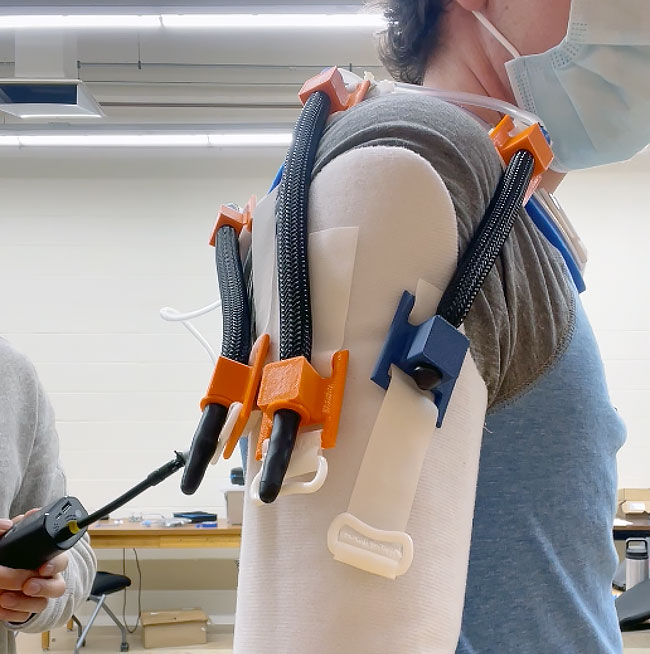
What if your clothes could contain robotics that help you move your arms or legs?
Mobility skills a lot of us take for granted could become available to people with mild to moderate disabilities, offering new opportunities for self-reliance and improved quality of life. People without disabilities could suddenly become stronger and more dexterous.
University of Virginia associate professor Sarah Sun, who has joint appointments in the Departments of Mechanical and Aerospace Engineering and Electrical and Computer Engineering, received a National Science Foundation grant to develop clothing-like robotics as assistive technology. The NSF grant is a Boosting Research Ideas for Transformative and Equitable Advances in Engineering (BRITE) Synergy Award that supports research into wearable robotic systems created with unique manufacturing processes.
"We are developing a prototype of a new wearable robotics that form a textile-based, flexible exoskeleton," Sun said. Exoskeleton is a biological term borrowed from other species who have their skeletons on the outside of their body.
With this assistive technology, those who suffer from neuromuscular diseases like cerebral palsy or ALS and have a loss of motor control could do things like drink a cup of coffee, have dinners and maintain daily activities. Beyond everyday self-sufficiency, the range of employment opportunities could open up," she said.

Her previous work includes designing specialized thread that contains flexible electronic circuits which can be stitched on fabric in patterns that resemble circuit boards. These boards can be arranged to create health devices right in the fabric, such as an electrocardiogram positioned over the heart to monitor a heart rate. Sun was the recipient of a 2019 NSF CAREER AWARD, System-on-cloth: A Cloud Manufacturing Framework for Embroidered Wearable Electronics. CAREER awards are the NSF’s most prestigious grants for early-career faculty, recognizing their potential for leadership in research and education.
Sun’s new technology embeds sensors in clothing. The sensors are programmed to learn the person's intended movements and give real-time instructions to small pieces of equipment called actuators that are also embedded in the clothing. The actuators use electrical signals to move metal splints along a wearer’s arms. A microprocessor manages all the signals between the sensors and actuators and together they literally create movements in arms and legs.
"The exoskeleton will be able to help them by providing mechanical force to their arms or legs to achieve the desired behavior," Sun said. “The system will be able to translate small movement attempts into agile rotary and linear motion.”
"In the past, assistive technology like this has been made of heavy plastic or metal. It was very cumbersome, and it could not be sized for a personalized fit, nor could the sensors be aligned with an individual’s health needs," she said.
The team is designing the new assistive technology so it can be made from low-cost fabric materials; manufacturing and product costs are expected to be low. This intentional design eventually will make the technology, aimed primarily at the disabled population, widely available, Sun said.
Sun leads a team of mechanical and aerospace graduate and undergraduate engineers as a part of this research conducted at her lab. Like so many other fourth-year capstone teams at UVA Engineering, these students are getting hands-on experience; in this case they are building leading-edge robotics.
“We have exceptional students,” Sun said. “And they’re so excited to be working on this.”
“It’s fascinating to create the technology from scratch,” said Nazirah Farach Rojo, a Ph.D. student working on the project. “We all have to work together to see what parts work and what parts don’t, then build or rebuild the changes and improvements. We are using team members as test subjects, so we are counting on their feedback for information. I love the iterative research and development process.”
Future plans for assistive exoskeletons include working with doctors and other medical professionals to develop and tailor more types of wearables to patient needs. Sun envisions a day when people could download personalized plans for an exoskeleton to a 3D printer and a sewing machine — she hopes to apply some her previous research to create stitching that would include the sensors — then put it all together and wear it. This type of manufacturing, one of Sun’s areas of expertise, is called “cloud manufacturing” because the product is created in various locations via internet downloads.
Other possible applications of Sun’s work include assembly lines of manufacturing companies. Some companies are already starting to use exoskeletons to help people who work on production lines, but these early models don’t include the machine-learning component being developed in Sun’s version. With assistance, workers could do superhuman feats like lifting objects that are too heavy without assistive technology. These augmented humans could also do repetitive movements that would normally cause fatigue. Companies view this kind of technology as an investment in safety.
Instead of robots replacing humans on the job, they could team up.